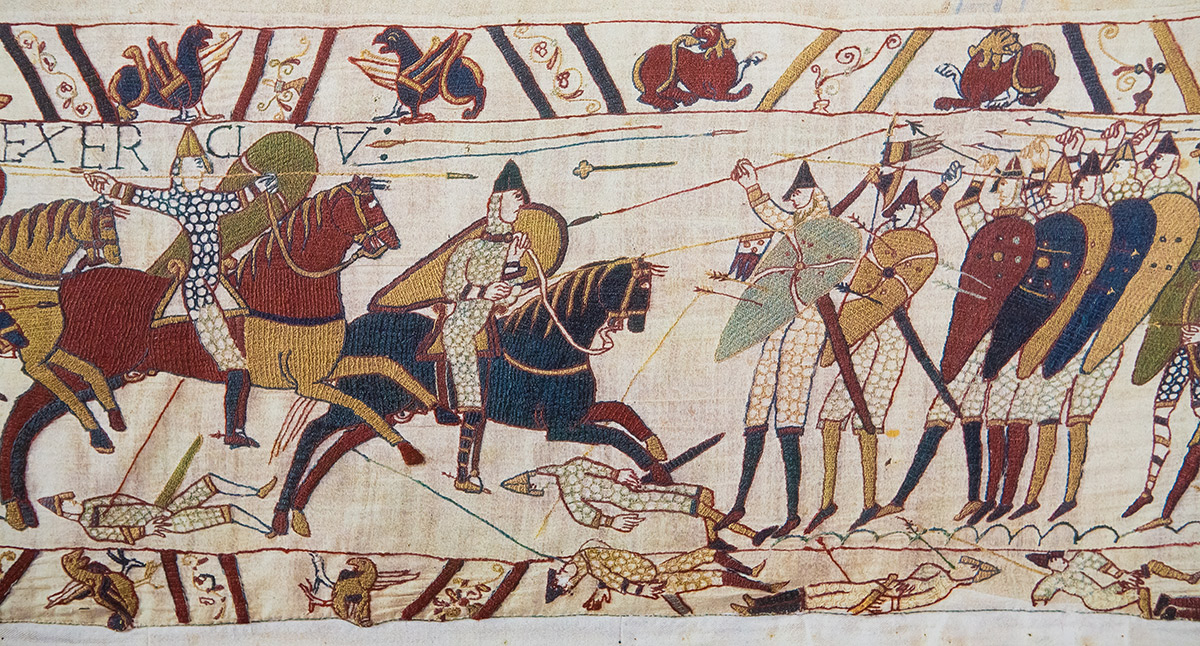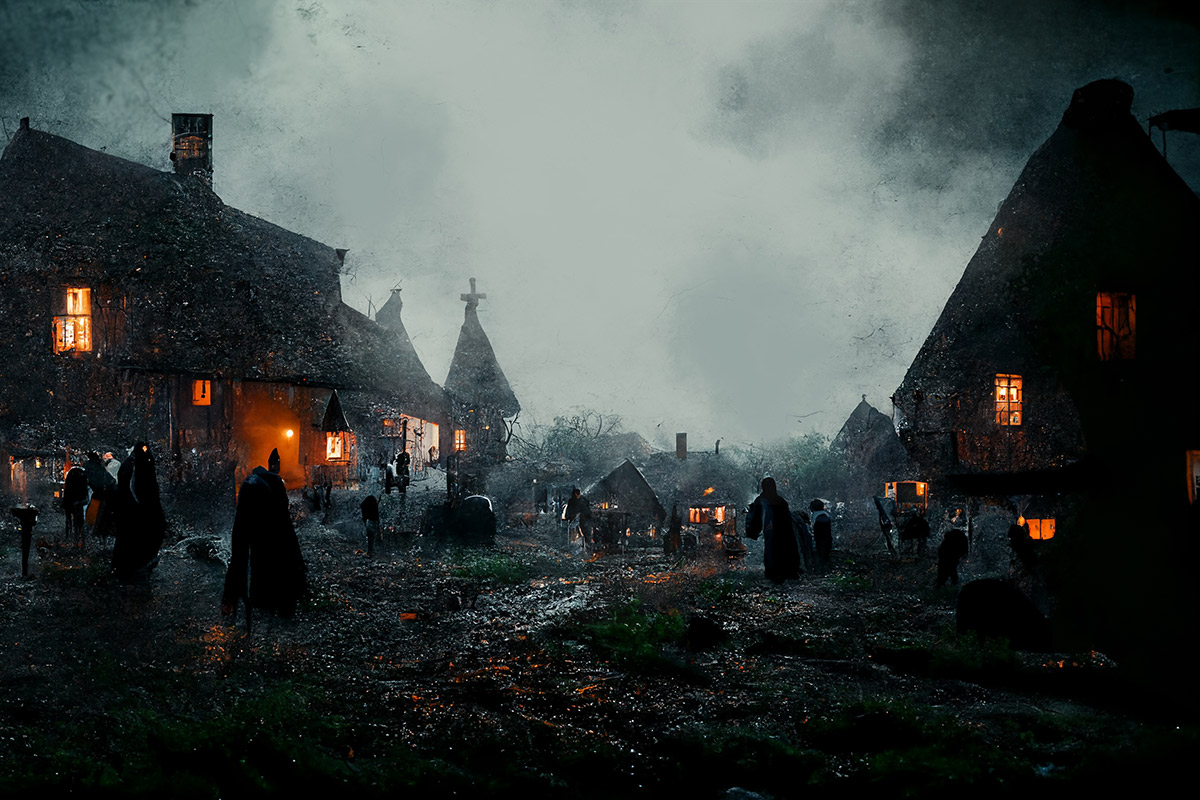The Normans
Production methods remained unchanged for a thousand years after the Roman occupation. Salt boiling was bound by ritual and tradition. Blood or white-of-egg was used as a coagulant for precipitating marl; urine, presumably as a froth flotation agent.
Until the 19th century, the main use for salt was to preserve food for the winter months. Salt was probably the first traded commodity. If not available locally it would have to come from afar by packhorse or boat (or, in desert lands, by camel caravan.)
The arrival of the Normans brought no immediate change to the salt making industry of Cheshire. The three “Wiches” continued to be held equally by the King (now William) and the Anglo-Saxon Earl Edwin.
But all this was to change following the rebellion of 1070 and William’s laying waste to the county. For a brief period Gherbod, the Flemish noble, was Earl of Chester, but after a year he returned home, William’s nephew Hugh of Avranches became the first Norman Earl and divided the Manors of the county amongst his men.
Northwich and Middlewich, were retained in lordship by Earl Hugh but the unnamed third Wich in the Hundred of Warmundestrou, (in time to become Nantwich) was granted to William Malbank and became known as Wich Malbank. In spite of the changes of lordship we know from Domesday that the Anglo-Saxon laws and customs of salt making were retained.
More Salt History:
- Salt During Our Early History (inc Ancient, Iron Age, Roman & Anglo Saxon Times)
- Salt in the Middle Ages (inc Normans, Late Medieval, the Black Death, Tudor & Stuart Periods)
- Early Modern Period (Technology & Change)
- Salt & the Chemical Revolution

The Lost “Wich”
Domesday also reveals that Cheshire had another “wich” in Anglo-Saxon times. The entry for the lost manor of Burwardestone includes a salt house which was claimed to have belonged to the Bishop of Chester.
But Earl Hugh had granted the manor with its salt house to Robert Fitzhugh and the 1094 Foundation Charter of the new Abbey of St Werberg in Chester records that a salt house “at Fulwich” was included in Robert Fitzhugh’s gift.
Burwardstone has been identified with the present day Township of Iscoyd which is now in Maelor Saiseg, the detached part of Flint, and adjacent to the Township of Wigland, in Cheshire.
The Fulwich brine pits were at two hamlets along the Wychbrook valley known as Higher and Lower (or Over and Nether) Fulwich. With the Statute of Rhuddlan in 1284 Flint was created and the river became the boundary with Wales but the Fulwich name was retained; maybe because brine pits were on both sides of the river. Later in the middle ages the name Fulwich was changed to Dirtwich.
According to Domesday the three Cheshire salt towns were waste in 1071, and they had only partly recovered by 1086. Droitwich in Worcestershire,on the other hand, suffered little damage as a result of the Conquest. Worcestershire Domesday lists 318 salt houses and refers to the existence of lead pans, a lead smithy, furnaces and the need for firewood.
There is however no mention of laws and customs although these are likely to have been similar to those in Cheshire. At this time and before 1066 Droitwich was much the most important centre of inland salt production and produced more than the whole of Cheshire.

Population & Salt Demand
Throughout history and up to the industrial revolution, the prime reason for making salt was the preservation of food for the winter months. If not obtainable locally it would have to be obtained from afar by packhorse or boat [or, in desert lands, by camel caravan.] Salt was probably the first traded commodity.
Clearly the demand for salt will have varied with the size of the population. Between 1066 and the mid-fourteenth century, England’s population roughly doubled and hence so did the demand for salt.
In addition to Worcestershire and Cheshire, there were many coastal saltworks. These were most numerous in the Lincolnshire and Norfolk Fenlands, and along the south coast especially, Sussex. These coastal centres maintained a considerable export trade of white salt with the continent, this being the prime source of the coastal industry’s prosperity.
The inland salt industry of Droitwich and Cheshire remained of local importance. Land carriage costs were such that any salt reaching London by this means would only be affordable by the rich. English salt was brought to London mainly from the coastal salt works but the chief source of salt was the Biscay coast.
With Henry II’s marriage to Eleanor of Aquitaine in 1152, a large area of south west France came under the English crown. There was an assured English and North European market for Gascon wine and Biscay salt. This trade prospered through the 13th century with imports into England through London and the ports of southern England. In London the trade of the salt merchants was localised in the Bread Street area and here they formed a Fraternity of Salters for their mutual aid; later to become a chief City Livery Company.
Brine Additives
The size of lead pan and the technology of open pan salt making remained essentially unchanged for over one thousand years but the only surviving documentary reference to the use of blood, eggs and ale as additives to the brine date from the 16th century. The protein in these additives helped to clarify turbid brine from the pit by forming a froth in which the fine suspended solid matter was collected and skimmed off. This technique called “froth flotation” is still used today in mineral processing. Agricola in De Re Metallica decribes the use of blood, eggs and ale as brine additives in early 16th century Saxony. It is possible that the common use of these additives in both Cheshire and Saxony may have been more than coincidence and could have dated back to the Roman occupation.
The Black Death
1348 brought the Black Death and this together with the other plagues of the mid 14th century almost halved the population, halving the domestic salt demand.
Together with rising sea level, this was to lead to a decline of the salt export trade of the Fenland ports. Coastal saltmakers near the main ports were to become importers and merchants of Bay Salt. In London the Salter’s Company dealt primarily in imported salt. Some coastal salt works eventually adopted the Dutch “salt on salt” process by which imported grey Bay Salt was re-crystallised from seawater to give a more acceptable white salt suitable for home sale or re-export at a higher price.
The Impact on Cheshire Salt Making
In Cheshire, the Black Death led to a reduction of salt demand which will have resulted in excess salt making capacity. Middlewich and Northwich were now Crown holdings. In 1349-50 the Bailiffs at the two towns collected customs monies called “Ernesselver”, “Herdelsalt” and “Struth” which related to the making of salt, its sale to merchants and the purchase of wood fuel for the pans.
In Nantwich, the division of the Malbank inheritance had resulted in a diverse ownership of the many salthouses – all competing in a limited market. While Middlewich and Northwich were small towns and very dependent on salt, Nantwich was the second largest town after Chester, with a diverse economy and thriving market.
The town had furthermore benefited from the accrued imported wealth of local gentry who had been the Black Prince’s “men” in Gascony. Salt thus played a less critical role in the Nantwich economy but there could have already been too many salt houses for the available brine from the Town Pit. A system of rationing could already have been in existence.
Many of the Nantwich ‘wich’ houses were owned by the local gentry, others were in monastic holding. The surplus salt making capacity and depopulation of the manors conceivably brought about changes in the pattern of agriculture with strip arable land put down to permanent pasture and the production of meat, butter and cheese.
Later town records show that women were employed by the Occupiers to work the salt pans as “wallers” while their husbands presumably worked in agriculture or had craft skills. This practice may have originated in the late 14th century.
According to Domesday, the salt houses of Nantwich were all within an area enclosed by the river and a ditch. By the mid 14th century this area had grown and there were now areas designated to be “Walling Land” on both sides of the river. No salthouses were allowed to be established elsewhere in the town. Mid 16th century documents and in particular a detailed survey of the town’s walling lands, made in 1624 show that there were 216 walling lands “of ancient inheritance”, each with six lead pans.
The owner of a walling land was entitled to a share of brine from the Brine Pit and the Rules of Walling laid down the days and times when brine was to be taken and made into salt. This was done, according to a rota known as “walling in kale”. When all 216 shares had been obtained there was a meeting at which new Rulers of Walling were elected and the procedure would start again.

It is apparent that a proportion of the pans at any time would be idle and by the 16th century it is not clear whether the owner or occupier of a walling land still owned operational salt pans or whether the land and buildings had been put to another use. The share of brine could then be made into salt in a borrowed salt house or if the owner held more than one salt house. One or more of these could be put to other use and the total share of brine made into salt in one salthouse.
Salt in the Tudor & Stuart Period
By the Tudor & Stuart periods the population of England had returned to the level preceding the Black Death. Salt was still brought to London from coastal salt pans of France and Southern England but by the 16th century a considerable quantity of salt came from Scotland where cheap coastal coal was evaporating seawater in iron pans.
Elizabeth, in the 1560′s, seeking to emulate the Scottish practice granted a patent for the use of new types of iron pan that would give the Tyneside salter a market advantage over the imported salt. Although unsuccessful, subsequent Tudor & Stuart administrations were to make repeated attempts to stimulate the coastal salt making so that all English salt needs would come from English and Scottish sources.
By the 17th century this involved negotiation with the Salters Company which had been now joined by the salt traders of the main East and South coast salt towns.
The Cheshire Salt Industry
Meanwhile the Droitwich and Cheshire inland salt industry had continued to supply the inland area of the North and West and had minimal impact on the London market. The fine salt produced by boiling brine in lead pans was considered less suitable for fishery use than the coarse sea salts and with the high cost of land carriage it was no doubt unable to meet London prices.
Another problem facing the Cheshire salt industry was the growing shortage of coppiced timber to fuel the fires for salt making. An increasing population demanded more agricultural land and the managed coppice woodland was also at a premium due to a competing demand for wood to produce the charcoal needed by the iron industry which had migrated into Cheshire from the south.
